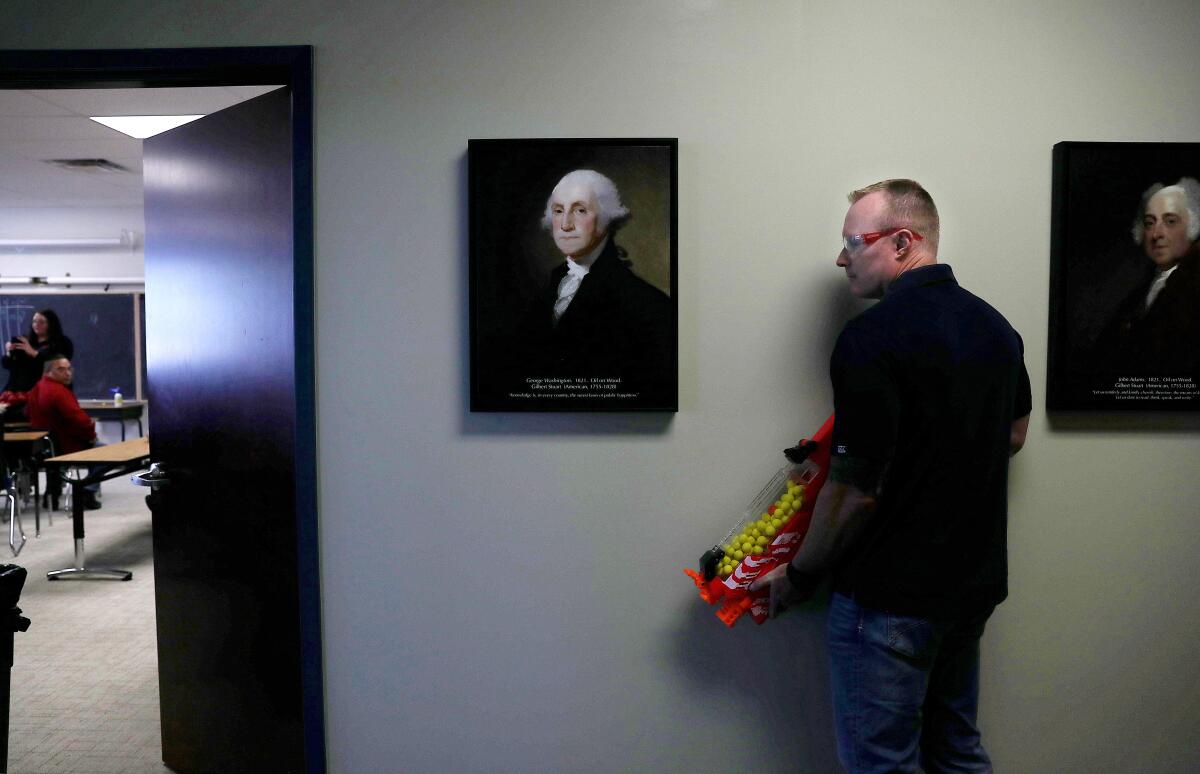Column: Active shooter drills are another example of how we’ve failed schoolchildren

My niece was helping her daughter at bath time when the 5-year-old asked, “Mom, what if a bad guy gets a ladder and breaks our class windows that are high up?”
The question elicited a moment of confusion before realization dawned. That morning my niece had received a text from her daughter’s school regarding a planned safety drill, but she hadn’t thought twice about it, not understanding at first that it might include a “lockdown drill” or an “active shooter drill.”
She struggled to find a good answer, and felt sick that she even had to field a question like that.
“I wanted to puke,” she said. “It hurt so deep inside me.”
Parents across the country are getting similar gut checks as the pace of school shootings escalates. They want their children to be as safe as humanly possible, but they can’t help feeling that subjecting kids to traumatic lockdown drills — in which school staff and students follow protocols for what to do if an armed assailant or other threat comes to campus — means that we’ve badly failed them.
Queasy feelings persist as we contemplate the damage we are doing to a generation raised with the belief that they might be the next victims. The tragedy of campus shootings becomes compounded by worries that we are psychologically scarring our children.
Among those voicing concern are mental health professionals who argue that the drills do more harm — by causing stress and anxiety — than good.
Nevertheless, lockdown drills are firmly embedded fixture of our culture and will no doubt continue.
Virtually every public school in the nation conducts some version of these drills. In California, they are mandated. Even pre-school kids have participated in “age-appropriate” exercises.
Of course, safety drills have long been a regular feature of school life. No one argues against the rationale that students should know how to respond if an earthquake strikes. Even the greatly mocked duck-and-cover routines that were common during the Cold War, when the specter of nuclear war was ever-present, didn’t arouse as much consternation as today’s drills.
Worries have mounted as lockdown drills have evolved over the past 20 years, becoming more intense and realistic. Sometimes the drills are organized by companies seeking to capitalize on our fear.
Drills are typically adjusted for age, but for many students they’re often alarmingly graphic, complete with simulated weapons and blood and people playing the role of a shooter. Though psychologists recommend providing advance warning, there have been occasions when students don’t know whether they’re undergoing an enactment or if it’s the real thing.
During a recent drill at a Huntington Beach high school, students in one classroom were forced to lock out their teacher, who had momentarily stepped across the hall when the alarm sounded. The kids were following the procedures they’d been taught, but I can imagine that at least some of them might have agonized over the thought of leaving their teacher in a more vulnerable position.
When it comes to prepping for the possibility of violence, school officials have been placed in an untenable position — damned if they do, but damned if they don’t take measures that would once have appeared unnecessarily extreme.
“There is nothing more anxiety-inducing for a school official than thinking about violence on their campuses,” said Phil D’Agostino, director of student and community services at the Newport-Mesa Unified School District. “There certainly is room for debate on the frequency and intensity of these drills, but we have to be prepared.”
D’Agostino said he couldn’t discuss specific strategies used in lockdown drills because “they could be used by people who wish to do us harm.”
But he shared that plans are updated annually and that the district continually reviews its procedures in close consultation with local law enforcement. For instance, after an off-campus incident triggered safety measures at Newport Harbor High School, district officials realized that they needed to augment the school’s radio communication.
“We had those radios in place in three weeks,” he said. “It was a high priority for us.”
Ultimately, lockdown drills might save lives, though there’s no hard evidence of that. For better or worse, they are now routine for school children, their parents and the teachers who are expected to be superhero guardians in addition to giving math and history lessons.
The fact that we’ve normalized these drills wouldn’t be so depressing if we actually did more to address the underlying issues, which include the toxicity kids are exposed to on social media, the persistent underfunding for school counselors and other mental health support, and — yes, this too — a dearth of political courage to enact common-sense gun regulations.
Teaching kids how to improve their odds of surviving a massacre might be necessary in today’s crazy world. But it’s also a sign that we’ve let them down. We can do better.
How to get published: Email us at john.canalis@latimes.com. All correspondence must include full name, hometown and phone number (for verification purposes). The Pilot reserves the right to edit all submissions for clarity and length.
All the latest on Orange County from Orange County.
Get our free TimesOC newsletter.
You may occasionally receive promotional content from the Daily Pilot.




